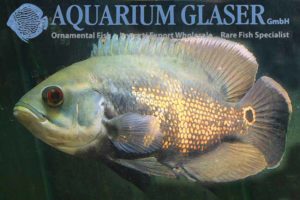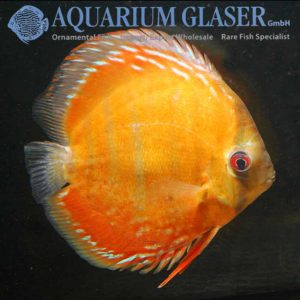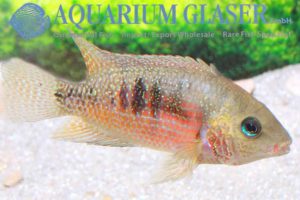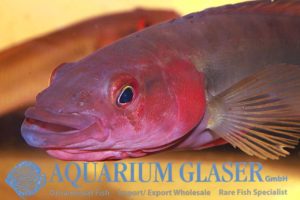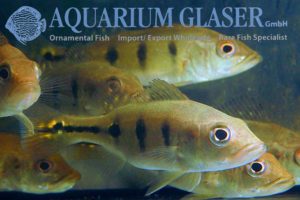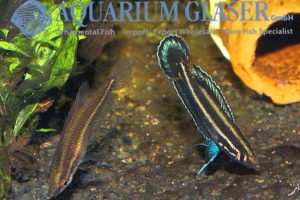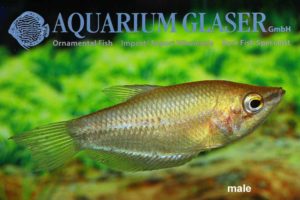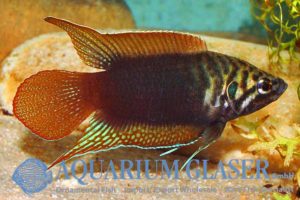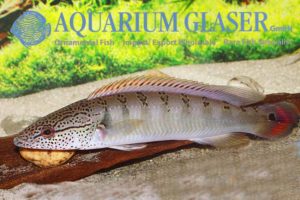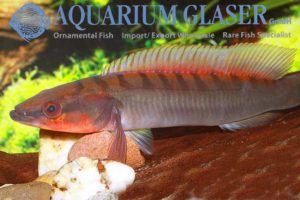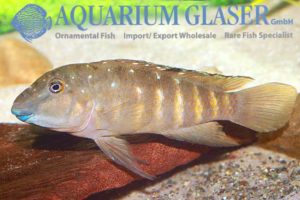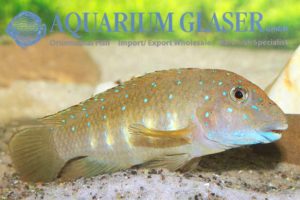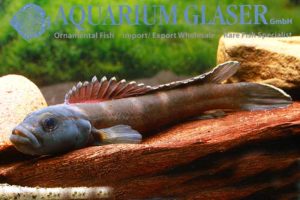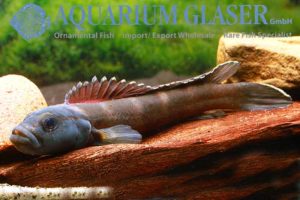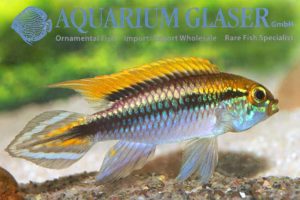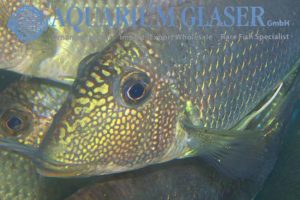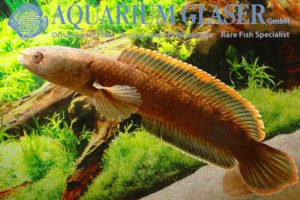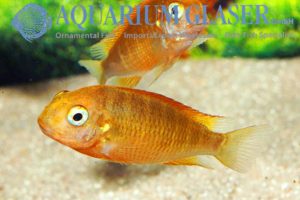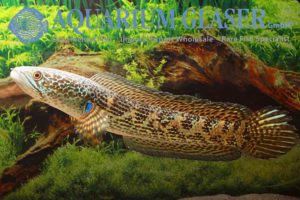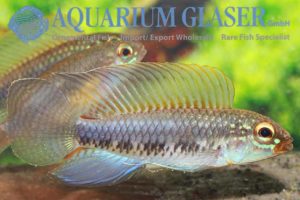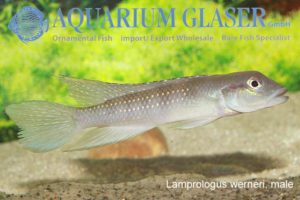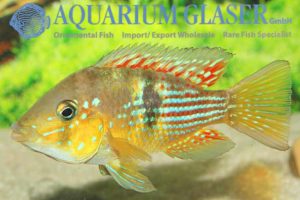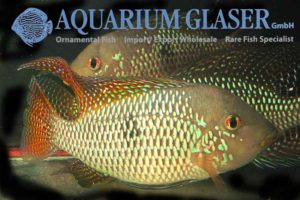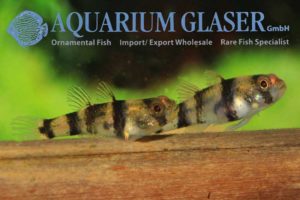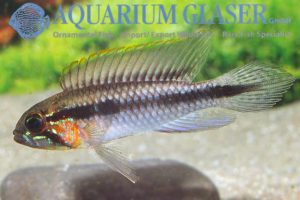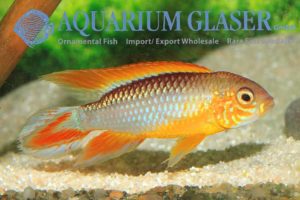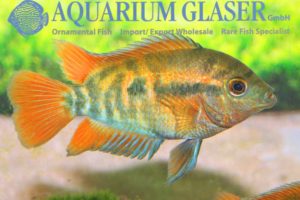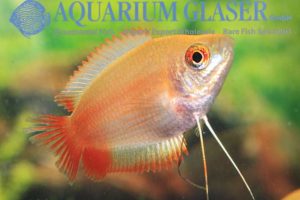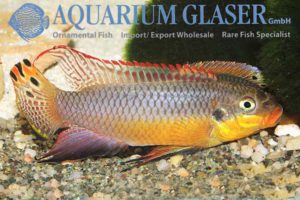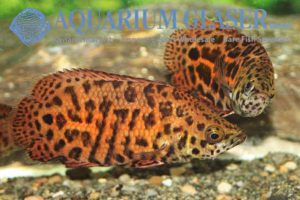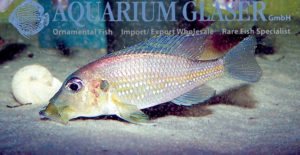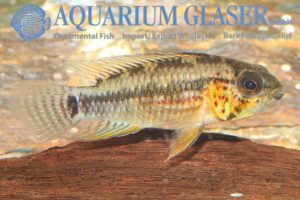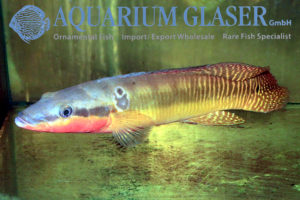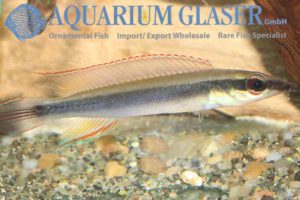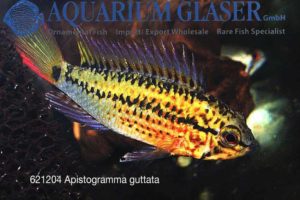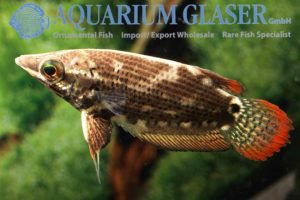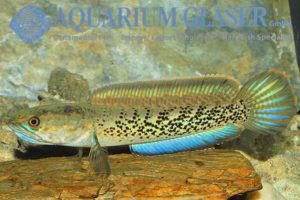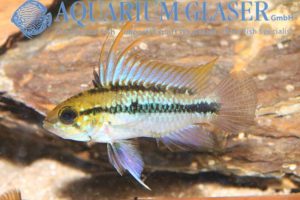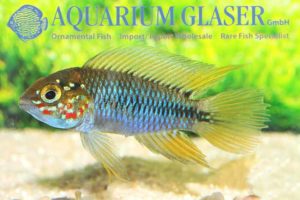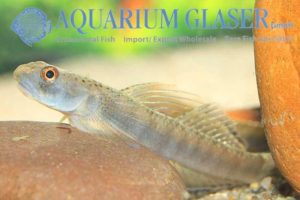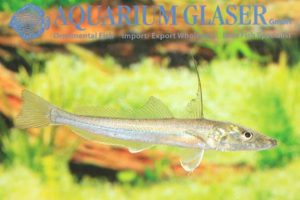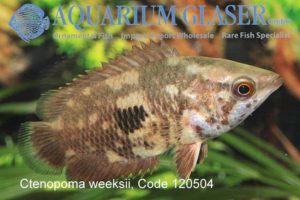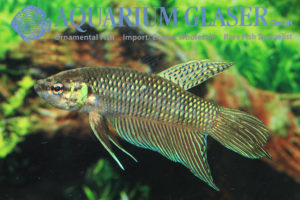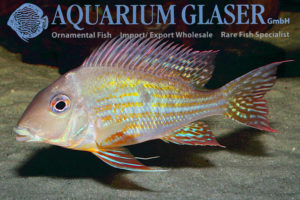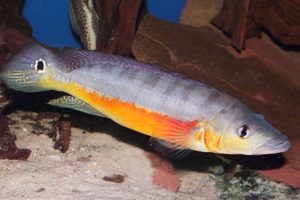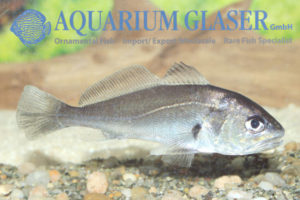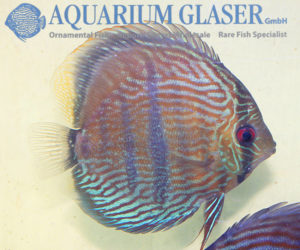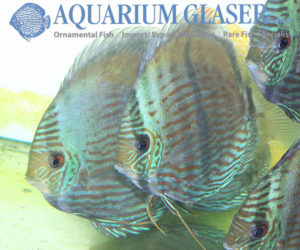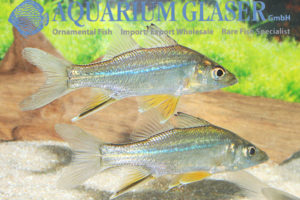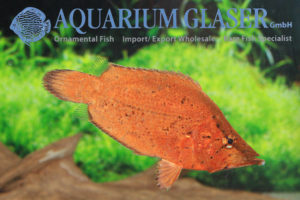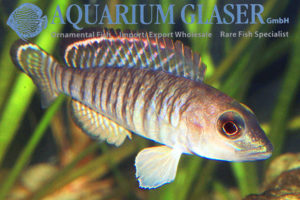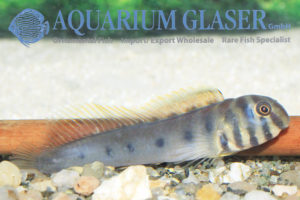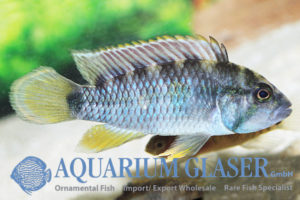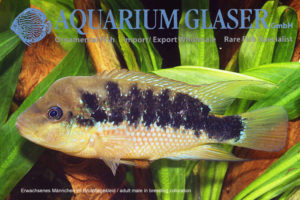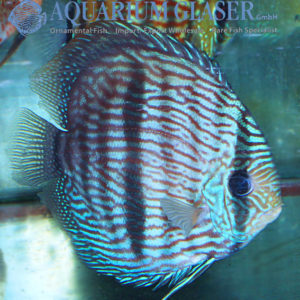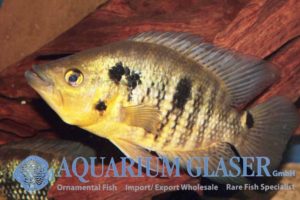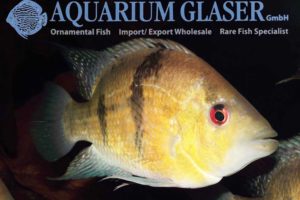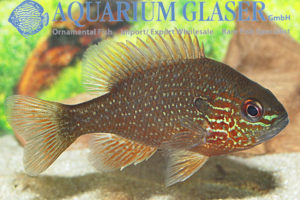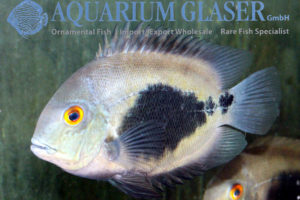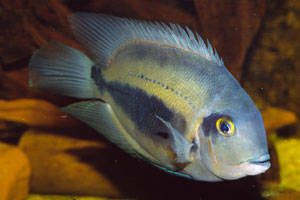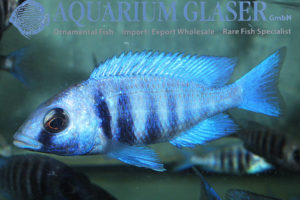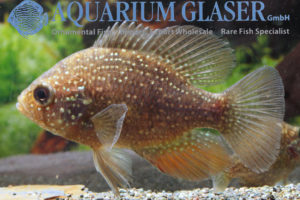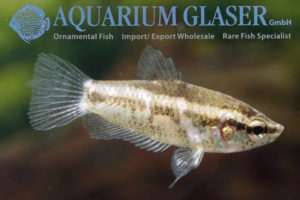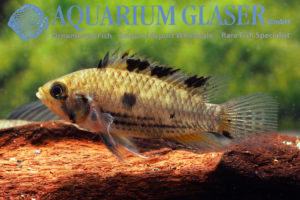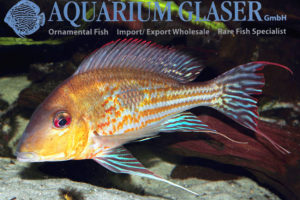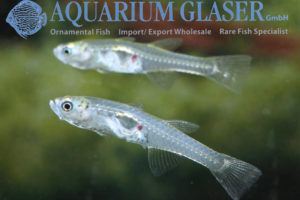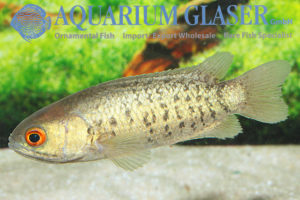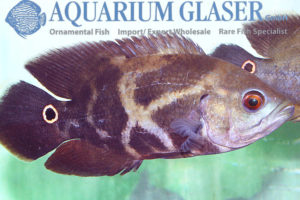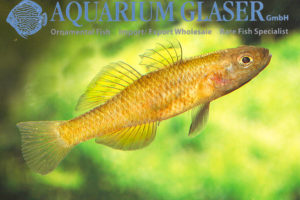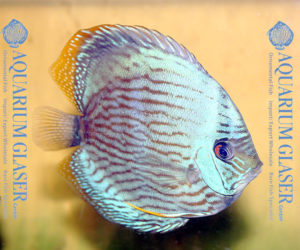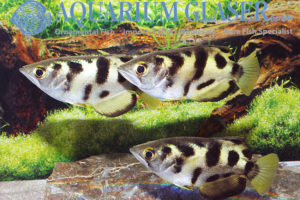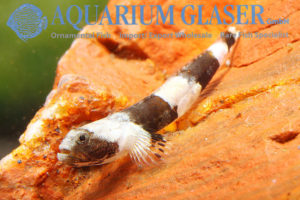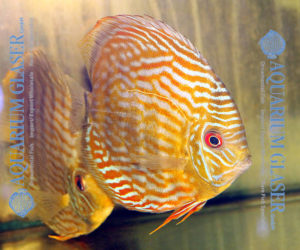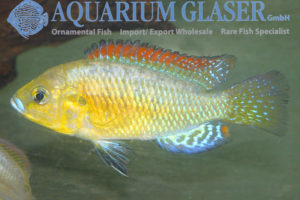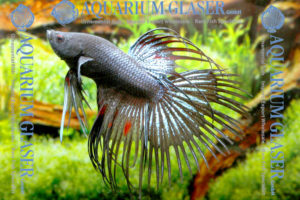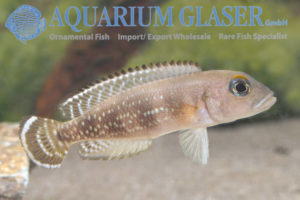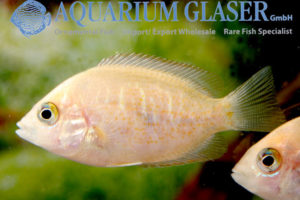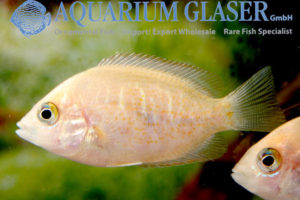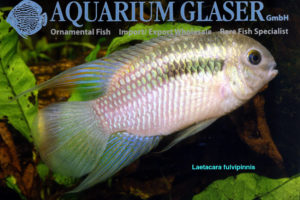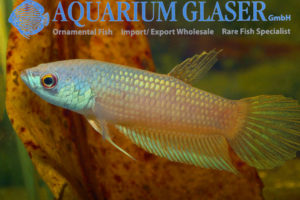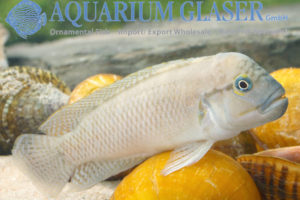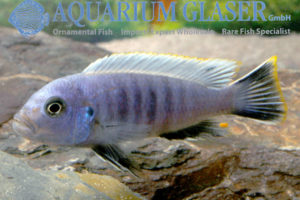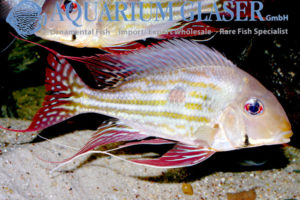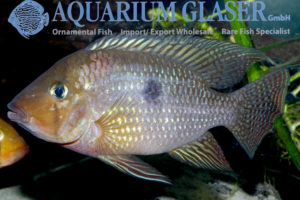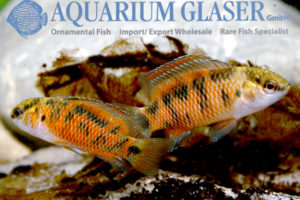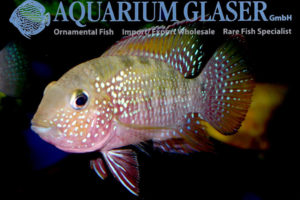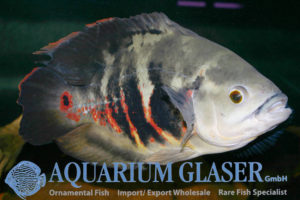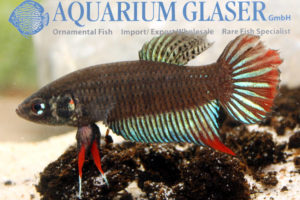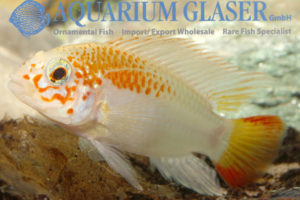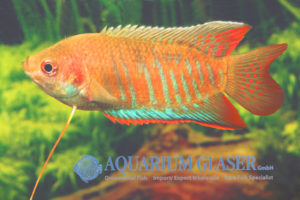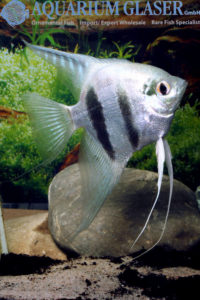We currently have some large wild collected oscars from Colombia in stock. Although oscars are always available as bred ones, wild collected ones belong to the real rarities in the market. For our customers: the fish have code 632508 on our stocklist. Please note that we exclusively supply the wholesale trade. Text & photos: Frank […]
25. Perchlike fishes (885)
-
-
Discus Red Maues / Lago Paraconi
Divine discus of this variety which have a very high degree of red coloration reached us recently. For our customers: the fish have code 739036 on our stocklist. Please note that we exclusively supply the wholesale trade. Text & photos: Frank Schäfer
-
Neetroplus panamensis, variety RED
We have received wonderful German bred specimens of this relative small, very colorful and extreme rarely offered cichlid. Males become around 13 cm long, females stay smaller. According to the latest systematic revision the fish is placed now in the genus Cryptoheros, subgenus Panamius. For our customers: the fish have code 684602 on our stocklist. […]
-
Pelvicachromis signatus
We recently received this beautiful dwarf cichlid from Guinea. The species is a close relative of P. humilis and was known in the hobby as P. sp. “Bandi 1” before its scientific description. Maximum size in males is around 10 cm, females stay always smaller. As in almost all Pelvicachromis there is an extreme sexual […]
-
Crenicichla cf. lugubris RED ATABAPO
At least we managed to import a small number of one of the most beautiful pike cichlids at all. Breeding fish become deep red all over the body, and even outside the breeding season the fish are spectacular. For our customers: the animals have code 670715 on our stocklist. Please note that we exclusively supply […]
-
Cichla kelberi
For the first time ever we have Cichla kelberi in stock, a species that was only recognized in 2006. The fish is available only in a very limited number. The species is distinguished from its closest relative, C. monoculus, by the presence of light spots in the pelvic fins, the anal fin and the lower […]
-
Crenicichla lugubris ORINOCO
We received beautiful Crenicichla lugubris from Venezuela in three sizes. It is astonishing how drastically these fishes change their coloration during their onotgenesis. Juveniles that show the typical “French fries pattern” are schooling fish that feel very unsafe when kept alone. Then the fish come in the age of puberty. Now they see congeneers only […]
-
Parosphromenus cf bintan SINTANG
The charming licorice gouramis are ideal inhabitants of nano tanks. They can not compare with other fish and so they settle even in nature extreme habitats. The water there is very poor in nutrients, very soft and acidic. These dwarfs among the anabantoids become astoundingly old and can easily reach an age of 5 or […]
-
Sphaerichthys acrostoma
Currently we have the rarest species of chocolate gourami in stock, the Golden Choco-Gourami. This is the largest of all species of Sphaerichthys, maximum length is around 6 cm. Keeping and breeding this species – it originates from Borneo – is comparable to that of S. vaillanti (http://www.aquariumglaser.de/en/sphaerichthys-vaillanti-_de_756.html) Text & Photos: Frank Schäfer
-
Macropodus ocellatus
Code 425403
-
Crenicichla sp. Atabapo
Code 672534
-
Crenicichla lenticulata
Code 670005
-
Crenicichla johanna Puerto Inirida
-
Tanganicodus irsacae “Ikola”
Code 576002
-
Eretmodus cyanostictus “Kavala”
Code 520502
-
Teleogramma brichardi
Currently we have a limited number of the very rare cichlid Teleogramma brichardi from the Congo in stock. For our customers: the fish have code 576303 on our stocklist. Please note that we exclusively supply the wholesale trade.
-
Teleogramma brichardi
Currently we have a limited number of the very rare cichlid Teleogramma brichardi from the Congo in stock. For our customers: the fish have code 576303 on our stocklist. Please note that we exclusively supply the wholesale trade.
-
Apistogramma agassizii Flamenco
Currently we received one of the most beatiful varieties of Apistogramma agassizii in limited numbers. The variety “Flamenco” is collected in the wild, but according to our exporter it does not represent a local population. The Flamenco variety is selected from other “normal” Apistogramma agassizii catches. It is well known that under aquarium conditions it […]
-
Satanoperca mapiritensis
We obtained this wonderful, glittering eartheater from Venezuela. The size is 15-18 cm. Members of the genus Satanoperca are also called “devilfishes”, but despite this horrible name the fish are extremely peaceful. They live over sandy bottoms which they browse through in search for food. In such a habitat it makes no sense to defend […]
-
Channa sp. Laos Fireback
For the first time ever we received this splendid snakehead, which obviously represents a species unknown to science so far. I reminds one strongly to the far spread and variety rich species C. gachua, but the “Fireback” is much bigger, reaching 15 -20 cm, it lacks the stripes in the pectoral fins, which are so […]
-
Tropheus sp. Yellow
Currently we have extreme beautiful Tropheus sp. “Yellow” in stock which already display bright colours when young! For our customers: the fish have code 586302 on our stocklist. Please note that w exclusively supply the wholesale trade.
-
Channa aurantimaculata
Just in: one of the most beautiful of all species of snakehead, available only in limited numbers. Size up to 40 cm, our fish currently are 20-25 cm long. For our customers: the fish have code 409014 on our stocklist. Please note that w exclusively supply the wholesale trade.
-
Apistogramma iniridae
Sadly this beautiful dwarf cichlid is only occasionally available, but currently we were able to import once more beautiful, fully grown specimens. The fish are very stable and display all the behaviour that makes the keeping of these fish so desirable. Like its close relative A. uaupesi, which differs from A. iniridae mainly due to […]
-
Lamprologus werneri
Most hobbyists think about the cichlids of Lake Tanganyika when they hear the generic name Lamprologus. But there do exist also some species of river-dwelling (= riverine) Lamprologus. The most attractive species among them is without any doubt Lamprologus werneri, which we were able to import now once more. The slender fish is spread all […]
-
Gymnogeophagus meridionalis
Currently we have magnificent (German pond bred!) specimes of that cichlid, which is almost a dwarf cichlid (our fish are between 5-7 cm long and fully mature and in colour) in stock. There is still no agreement among the specialized aquarists, if this form represents a population of Gymnogeophagus meridionalis, G. rhabdotus or if the […]
-
Geophagus iporangensis
There are more exotic fishes that can be kept and bred at least seasonally in garden ponds than most aquarists think of. Among these species are for sure the different types of Brazilian Pearl Cichlids, the Geophagus-brasiliensis-complex. The group is only poorly understood scientifically, but who cares for names if one looks at these glorious […]
-
Brachygobius aggregatus – one of the smallest fishes of the World
All species of bumblebee gobies (Brachygobius) are small or very small fishes. The debate which is the smallest fish of the world (and coincidently the smallest vertebrate of the world) is still going on; however, it is quite difficult to decide, whether it makes sense to debate about differences of tenth of millimeters in live […]
-
Apistogramma gephyra
This pretty blackwater Apistogramma is imported only very occasionally. Now we were able to manage one of these rare imports again. The fish originates from Brazil where it is found in the central Rio Negro and lower Rio Branco basins. A. gephyra looks quite similar to A. agassizii and its aquarium maintenance is comparable to […]
-
Apistogramma agassizii FIRE-RED
Currently we have wonderful, fully grown specimens of this marvelous sport in stock, originating from German breeders. The fish literally seem to glow from inside! It is very interesting that the typical polychromatism that can be observed in wild populations of this dwarf cichlid is also found in this artificial sport. Polychromatism means that coloration […]
-
Herotilapia multispinosa
This medium sized cichlid – males can become about 12 cm long, females always stay 3-5 cm smaller – originates from Central America (Nicaragua, Costa Rica, Honduras). The fish is a real classic among the species of ornamental fish. It was most popular in the 1970ies. At that time the name “rainbow cichlid” was given […]
-
Colisa chuna “Fire” – A new sport of the honey gourami
Currently we received this extremely cute new sport of the honey gourami from Singapore. The honey gourami is the smallest known species of Colisa and becomes only 3-5 cm long. The new variety has the yellow-golden body of the well known “Gold”-variety of Colisa chuna, but the tail, the caudal fin and the soft parts […]
-
Pelvicachromis taeniatus Nigeria Yellow
This is another, extreme beautiful variety of that gorgeous dwarf cichlid from Western Africa: Pelvicachromis taeniatus “Nigeria Yellow”. Initially the animal originates from the surroundings of the Nigerian city of Lagos, but we have in stock fully grown adult bred ones. The bright golden breast and the very long finnage make Pelvicachromis taeniatus “Nigeria Yellow” […]
-
Ctenopoma acutirostre wild
It is been a quite long time since we had the last importation of this bushfish from the D. R. Congo. Immediately after their arrival the animals had an unbelievable strong coloration. Sadly it bleached out a bit over the time, but still looks great. Read more about the leopard bushfish here: http://www.aquariumglaser.de/en/archiv.php?news_id=140 For our […]
-
Gnathochromis permaxillaris arrived
This week we received bred specimens of this very rare cichlid from Lake Tanganjika. A breeding report can be found at http://www.aqualog.de/news/web3/3-7.pdf For our customers: the fish has code 520703 on our stocklist. Please note that we exclusively supply the wholesale trade. Lexicon: Gnathochromis: ancient Greek, means “jaw-chromis”, referring to the very special mouth structure. […]
-
Apistogramma sp. Assurini
Currently we received a new Apistogramma from Brazil, a close relative of the species known as A. sp. Xingu in the hobby. Like most Apistogramma, A. sp. Xingu, which has been imported in 1988 for the first time, has developed a number of varieties. Some of them appear within one population, others seem to represent […]
-
First import! Crenicichla zebrina arrived
This pike cichlid was discovered only in 2002 and described scientifically in 2008. It originates from the lower Ventuari river, the largest tributary of the upper Orinoco in Venezuela. The Ventuari is a clearwater river. Although the Ventuari river is rather good sampled, the describers of that unique species were not able to obtain more […]
-
Crenicichla cf. regani Orinoco
The pike cichlids (Crenicichla) are one of the world´s most specious genera of cichlid. Currently 85 species are accepted. Many of them grow larger than 20 cm but there are also dwarf species. The beautiful, slender Crenicichla regani, which is said in literature to grow to a maximum size of 15 cm (male) or 8 […]
-
Apistogramma guttata
Code: 621204
-
Ctenops nobilis
Chocolate gouramis are very beautiful, but demanding anabantoids. Thus they should be kept by experienced aquarists only. There are three genera of chocolate gourami, Sphaerichthys (four species), Parasphaerichthys (two species) and Ctenops (monotypical). The only species in Ctenops is nobilis, the Noble gourami from India. It represents the largest of all chocolate gouramis and can […]
-
Channa stewartii
Code: 409304
-
Apistogramma trifasciata
In case this dwarf cichlid would not exist it would be necessary to invent it for the aquarium hobby. Apistogramma trifasciata is an ideal aquarium inhabitant. The species stays small – males around 5 cm, females around 4 cm. It is completely undemanding regarding water chemistry – keeping and breeding is possible even in medium […]
-
Apistogramma borellii
Recently we received beautiful wild collected specimens of A. borellii from Paraguay. This species is an ideal aquarium fish. In contrast to many other species of the genus A. borellii is completely undemanding regarding water chemistry. Even in medium hard, slightly alcalic water the species thrives well and even breeds. The behaviour of A. borelli […]
-
Stiphodon sp. Spotted Head
Code: 456043
-
Sillaginopsis panijus
The difference between “foodfish” and “ornamental fish” is often hard to tell. For example, who in Europe would term the zebra barb (Danio rerio) a foodfish? Nevertheless hundreds of thousands of these tiny animals are collected daily in India, become dried and are sold as a spice. On the other hand young examples of attractive […]
-
Ctenopoma weeksii
For our customers: the fish have code 120504 on our stocklist.
-
Betta mahachaiensis
Code number: 377103 Photo: Frank Schäfer
-
Geophagus altifrons “Alenquer”
Code number: 675003 Photos: Thomas Weidner
-
Crenicichla vittata
Code number: 673612 Photos: Thomas Weidner
-
Plagioscion squamosissimus
Croakers, also called Drums (Sciaenidae) are a fish family that comprises about 290 species. Most of them are marine, but some occur exclusively in fresh water. In South America about 20 species and 4 genera are known to live in fresh water. The smallest among them becomes only 7 cm long (Pachypops pigmaeus), most become […]
-
Discus Heckel Cross
The term “discus Heckel cross” is given for fish with a broader central bar on the body, the so called “Heckel bar”. Despite this the fish are very different and probably also originate from different regions. Among them are real gems, some with a high degree of red body colouration. For our customers: the fish […]
-
Discus Heckel Blue Body Nhamunda
Currently we have beautiful, large Heckel discus from the Rio Nhamunda in stock. The characteristic feature of that variety is the bright blue sash-like band. For our customers: the fish have code 734095 on our stocklist. Please note that we exclusively supply the wholesale trade. Text & photo: Frank Schäfer
-
Centropomus unionensis
The snooks (Centropomus) are distributed in the New World; currently 12 species are recognized. Persons that are reminiscent of giant perches (Lates) by looking at snooks are not wrong: until quite recently the snooks and the giant perches were united in a single family, Centropomidae. We were now able to import a pretty species of […]
-
Monocirrhus polyacanthus
The Leaffish, Monocirrhus polyacanthus, belongs to the most astonishing species of freshwater fish at all. The species – the genus Monocirrhus is monotypical – is spread all over the Amazon basin. It is found in Bolivia, Brazil, Colombia, Peru, and Venezuela. Our imports usually come from Peru, so the current one does. The Leaffish belongs […]
-
Lamprologus signatus
This beautiful cichlid from Lake Tanganyika belongs to the dwarf cichlids. Males become around 5.5 cm, females around 3.5 cm long. At the first glimpse one would think that these tiny fish are “snail brooders”, e.g. that the females would spawn only in empty snail shells. However, this is not true. In their natural habitat […]
-
Omobranchus zebra
Omobranchus belongs to the Blenniidae family, most of which live in marine environments. Due to their funny behaviour and the generally easy keeping the blennies are favorite fish of the marine hobbyists. There are only very few species that settle permanently in fresh or brackish water. One of the latter is the pretty Omobranchus zebra, […]
-
Apistogramma panduro var. “Marsel”
We were able to import this new dwarf cichlid from Peru now. The fish is without any doubt a close relative of the species Apistogramma nijsseni, A. panduro and the still undescribed A. sp. “Inka II”. In contrast to these species the seam around the caudal fin in males is yellow instaed of red-orange. The […]
-
Cichlasoma istlanum
The large cichlids from Central America are a bit out of fashion currently. That is a sad thing, for hardly any other fish combines in such a perfect matter brillant coloration, personality and interesting behaviour. Of course these fish need large tanks and an equipment that fits their needs, but if these things are given […]
-
Discus champions on a visit
Once more our Japanese friend Mr Akira Ishinabe has placed his discus he displayed in the current discus championship in Duisburg in our facility to give them an opportuntity to rest a bit after the stress of the exhibition before they turn back home to Japan. His Green Wild was able to get the first […]
-
Caquetaia kraussii
In the wild, Caquataia kraussii is something like a million fish. There is literally no waterbody, may it be pond, lake, or river in the Llanos of Venezuela without this cichlid. So the cichlid enthusiast is a bit left alone with the question why it takes so long if one searches for this fish in […]
-
Caquetaia myersi
Caquetaia myersi belongs definetly to the real rarities in the aquaria of the world. The main reason for this is the fact that it occurs in the wild far from the usual collecting sites in Colombia. What makes fishing in those areas even more difficult is the presence of guerilla which has quite different interests […]
-
Lepomis megalotis
Sunfishes belong to the most colourful species of coldwater fish. The most widespread species in the hobby is Lepomis gibbosus, but the genus comprises not less than 12 species. Lepomis megalotis is native from NE-Mexico to the Great Lakes in the US and is additionally introduced in many countries. Up to six subspecies have been […]
-
Uaru amphiacanthoides
Extremely beautiful, fully grown specimens of this amazonian species of cichlid reached us now from Brazil. Uaru are peaceful fishes that can be best compared with discus regarding demands on water quality and temperature. However, Uaru are more or less specialized herbivorous fishes. For our customers: the fish have code 688517 on our stocklist. Please […]
-
Uaru amphiacanthoides
This large cichlid, which can grow up to 30 cm in length, has a wide distribution throughout South America. Despite its modest colouration and considerable size this species is well known in the fish tanks of the aquarium hobbyist, mainly because of the interesting behaviour and the lack of aggressiveness against fellow tank mates. Especially […]
-
Placidochromis sp. “Phenochilus Tanzania”
The generic placement of the Malawian cichlids formerly lumped in the genus Haplochromis depend on their melanin pattern, eg the black markings in the basic coloration. Sadly the melanin pattern is not recognisable in the only existing type specimen of Haplochromis phenochilus, which was described in 1935; thus its correct generic placement remains unknown until […]
-
Enneacanthus gloriosus
The Bluespotted Sunfish (Enneacanthus gloriosus) is a coldwater fish and a real oldtimer among aquarium fish. Aquarists used to name the up to 7.5 cm long fish “working class discus”, due to its brillant colours and the nice behaviour. However, it was never as expensive as the discus. Bluespotted Sunfish occur in nature along the […]
-
Parasphaerichtys lineatus
Once more we have the smallest anabatoid fish of the world in stock: Parasphaerichthys ocellatus, the mini chocolate gorami. This tiny species hardly reaches 2 cm in length. In contrast to all other chocolate gouramis this is a bubblenester builder (all others are mouthbrooders) and should be kept and bred in harder, slightly alcalic water […]
-
Apistogramma cactuoides WILD
Some species of fish are very popular in the aquarium hobby. Many of them are kept only as sports or breeding forms that do not exist in the wild and most aquarists are completely unaware how the wild form looks like. One of these species is the very popular dwarf cichlid Apistogramma cacatuoides. The species […]
-
Geophagus megasema
There is almost no chance that commercial importations of wild collected Geophagus megasema will ever appear. So it is very welcome that travelling aquarium enthusiast collect such species in areas that are ignored by professional fish collectors and bring them home alive, which makes it possible to develope a captive bred stock. Geophagus megasema was […]
-
Gobiopterus chuno
Glass perches and glass catfish are well known and common aquarium fish. But do you know glass gobies, too? The members of the genus Gobiopterus (there are so far 9 known species) are tiny freshwater gobies. They reach only 2-3 cm length and are so transparent that the observer can see how a food item […]
-
Anabas cf. macrocephalus
The Climbing Perches (Anabas) are no popular aquarium fish at all. Scientists also do not work on them and so the systematics of the genus are quite unclear. Members of the genus can be found all over the tropical and subtropical areas of South and Southeast Asia. However, it often remains unclear wether the fish […]
-
Astronotus ocellatus wild, Colombia
The Oscar, Astronotus ocellatus, belongs to the most popular species among the large cichlids. It was imported to Europe in 1929 for the first time. In Asia, many different sports have been bred since. However, the wild ancestors of the Oscar remain somewhat mysterious and little understood. Until recently, only one or two species were […]
-
Mugilogobius rexi
This small, yellow goby is a free swimming species, in contrast to most of the other gobies. Maximum length is about 4-5 cm. Territorial males become bright yellow and also develope larger fins with dark bands. Females are much paler in coloration and have translucent fins. The species is restrictet to Sulawesi and even on […]
-
Discus Heckel / Jatapu
The series of astonishing wild collected discus we are able to offer right now does not break off. Besides the wonderful Royal Blue which we introduced to you last week, we also have excellent Heckel blue-head said to come the Jatapu river. This branch of the Amazon river has an unique mix of fauna found […]
-
Toxotes sp. New!
A new species of Archerfish! Recently we received a shipment containing archerfishes (Toxotes) from Thailand. Most of the shipment were T. jaculatrix (see http://www.aquariumglaser.de/en/toxotes-jaculatrix_en_1076.html) and some T. chatareus (see http://www.aquariumglaser.de/en/toxotes-chatareus_en_1044.html). But a closer look showed also four specimens of an unique colored archerfish, which we have never seen so far and which fits to none […]
-
Schismatogobius ampluvinculus
We received for the first time now this cute goby from Taiwan. Especially when it is in the right mood it looks extremely pretty due to its contrasting black-and-white coloration. One of the generic characteristics of Schismatogobius is the fact that they have an individual coloration: there are not even two specimens with the exact […]
-
Discus Royal Blue Novo Ariguana
Yesterday (2.2.) we received breathtaking beautiful large wild collected discus called Discus Royal Blue Novo Ariguana. All insiders will understand that the fish do not show all of their beauty today, but even what they show is amazing! Text & photo: Frank Schäfer
-
Pseudocrenilabrus multicolor victoriae
This extreme beautiful small cichlid has changed its name quite often. Initially it was introduced to the hobby under the name Pseudocrenilabrus philander dispersus. The natural distribution area of this subspecies is Uganda. Only bred specimens are traded. The fish are agamous maternal mouthbrooders, which means that the males and the females do not build […]
-
Betta splendens Crowntail Black
Crowntail bettas become more and more popular. Although they exist probably since the 1960ies and although the gene for “crowntail” is dominant, these fishes became popular in Europe and the US only in the beginning of this millenium.The exact origin of this cultivated form is not documented in literature. The first citable appearance we know […]
-
Neolamprologus meeli
Among the snail-dwelling cichlids of Lake Tanganyika are some species that look very much alike and in some cases it remains still unclear whether the scientific name applied on them is correct or not. Neolamprologus meeli has been described in 1948 by Max Poll from a place near Katibili which belongs to the Congolese part […]
-
Etroplus maculatus
The Indian cichlid, Etroplus maculatus, is a very popular aquarium fish and never disappeared after its first importation again. Recent research suggests that Etroplus is not a close relative of the cichlid family, but rather of the damselfishes (Pomacentridae). However that does not mean anything for the hobby. Etroplus maculatus can be kept and bred […]
-
Etroplus maculatus “Gold-Blue”
The Indian cichlid, Etroplus maculatus, is a very popular aquarium fish and never disappeared after its first importation again. Recent research suggests that Etroplus is not a close relative of the cichlid family, but rather of the damselfishes (Pomacentridae). However that does not mean anything for the hobby. Etroplus maculatus can be kept and bred […]
-
Laetacara araguaiae
Laetacara sp. „Buckelkopf“ described scientifically. Laetacara sp. „Buckelkopf“ is known in the hobby for many years already. The somewhat unusal common name (the German word „Buckelkopf“ means „humphead“) derives from the feature developed by some very old males, but this happens rather seldom. It is a typical dwarf cichlid, the males grow to a length […]
-
Betta kuehnei
The mouthbrooding fighting fishes of the Betta pugnax group are wideley spread over Thailand, Malaysia and Indonesia. The most currently described species is Betta kuehnei from the northernmost Province Kelantan of Malaysia and the southernmost parts of Thailand. The species has been discovered by the travelling aquarist Jens Kühne and introduced in the hobby as […]
-
Telmatochromis temporalis
Snail-cichlids are a specialty of Lake Tanganyika. Of course also other places on earth exist where empty shells of snails are used by fish for hiding or breeding. But nowhere else than in Lake Tanganyika are so many specialized species. In Lake Tanganyika real fields of empty snail-shells exist. Empty shells that lie here and […]
-
Cynotilapia axelrodi
Currently we have received beautiful C. axelrodi from a breeder. The animals are full in colour and about 4-6 cm long. Maximum length for this species is given around 9 cm. Cynotilapia are typical mbuna cichlids. They differ from the closely related Maylandia (the zebras) by the dentition. Keeping is identical, which means they need […]
-
Geophagus winemilleri
The main distribution of Geophagus winemilleri is the southern part of Venezuela. Nevertheless most imports come from Brazil, because the species also occurs in the Rio Negro. G. winemilleri becomes often confused with G. proximus and a second, still undescribed or unidentified species. However, G. winemilleri can be identified by the dark spot on the […]
-
Geophagus sp. „Rio Sao Francisco“
This pearl cichlid from the Rio São Francisco can reach a total length of about 25 cm and thus should be kept in relatively large aquaria of 400 litres and more. Although pearl cichlids are known to be relatively aggressive this particular species is quite peaceful if the tank is large enough. Even when taking […]
-
Badis “Piebald”
Currently among the specimens of Badis badis bred by commercial breeders relatively often aberrant specimens are found. A closer look on these fishes reveils that besides the unusual irregular black pattern the basic body colour is a deep red. There can be no doubt that these animals are hybrids. Quite recently only one species with […]
-
Bujurquina oenolaemus
Bujurquina oenolaemus: This very pretty species of Bujurquina originates from Bolivia and was described scientifically as early as 1987 by Kullander. It took almost 20 years before the first living specimens were brought to Austria, Switzerland and Germany by travelling aquarists. Soon after breeding was successful and so the species was spread in the hobby. […]
-
Astronotus sp. „Bahia Red“
Sadly it was not possible to research if this Astronotus really was collected in the Brazil state of Bahia. Currently no scientific reports of the occurence of the genus in Bahia are known. So we have to leave the question open, if this population was brought to Bahia as a food fish or if they […]
-
Betta siamorientalis
(formerly: Betta cf. imbellis „Vietnam Black“). We import from Vietnam a pretty wild collected Betta for some time now. The exact determination of that species proofed to be quite complicated. There are four scientifically described species from this complex: Betta imbellis, B. smaragdina, B. splendens, and B. stiktos. An additional species is already known in […]
-
Apistogramma viejita GOLD
For the first time we can offer now this beautiful dwarf cichlid in a golden sport. This sport does not occur in nature. The contrasting golden and red colours make the fish extremely attractive. As Apistogramma viejita originates from Colombia it should be kept at higher temperatures as usual, eg 26 – 28°C. Water should […]
-
Colisa cf. fasciata
The northern states of India are hardly researched in respect of the fishes. From the state of Manipur we currently received exceptionally colorful gouramis of the genus Colisa, which represent a species new to science. They are without doubt close relatives of the species Colisa fasciata, C. bejeus, and C. labiosa, but differ from all […]
-
Blue Angel Showsize
In January 2009 we presented to you the new blue dwarf angel (http://www.aquarium-glaser.de/en/pterophyllum-scalare-blauer-zwerg–blue-dwarf_en_1071.html). In the meantime the breeders were pretty active and crossed the blue dwarfs onother strains of angels. So now we are able to supply also blue angels in showsize, which are almost as big as angels of other colour varieties. Text & […]
Available again: Sphaerichthys selatanensis

After a long time we were able again to stock the beautiful Sphaerichthys selatanensis from Borneo.

Read more about the species under: http://www.aquariumglaser.de/en/fish-archive/labyrinthfish-en/Sphaerichthys_selatanensis_en/
A new sport of paradise fish

The paradise fish (Macropodus opercularis) was the first exotic species of ornamental fish at all and is kept and bred continously in aquaria since 1869. Until today it can be considered to be one of the most beautiful and interesting fish. Moreover it is very easy to keep and breed.

There are only very few sports of the paradise fish. The best known is the blue sport which was developed in the 1950ies. Albinos exist much longer already. Only in the 1990ies a stripeless, deep red sport was developed by the breeders of ornamental fish.
For the first time ever we now received stripeless blue fish which have a broad red band on the flanks.

For our customers: the fish have code 425813 on our stocklist. Please note that we exclusively supply the wholesale trade.
Lexicon: Macropodus: ancient Greek, means “with great fins”. opercularis: the term refers to the dark spot on the operculum.
Suggestion of a common name: Blue Flame Paradise Fish; trade name: Paradise Fish “Blue/Red band”
Text & photos: Frank Schäfer
Discus season!
The season for wild collected discus is running now and we can offer a great number of marvellous animals, for example from the Nhamunda-Maracanha region (please, see also http://www.aquariumglaser.de/en/fish-archive/discus-en/Diskus_Nhamunda_rose__en/, http://www.aquariumglaser.de/en/news/Nice_Discus_wildcaught_available__en/, http://www.aquariumglaser.de/en/fish-archive/discus-en/Diskus_Nhamunda_rose_en/ and http://www.aquariumglaser.de/en/news/Discus_Royal_Blue_Nhamunda_Maracanha_en/):

731306 Blue Nhamunda Maracanha

731356 Royal Blue Nhamunda Maracanha

731365 Semi-Royal Blue Nhamunda Maracanha

731405 Rose Nhamunda Maracanha
For the first time we have wonderful Discus Caiambe in stock. Although these are wild collected fish, they cannot be assigned properly to the Green or the Brown/Blue Discus. Some specimens have red dots on the flanks, a phenomenon that can be found in Green discus also.

732505 Caiambe

732505 Caiambe

732515 Caiambe Few Spot
And last but not least we also have pretty discus from the Rio Aripuana in a semi-royal selection and a good size in stock.

735995 Semi-Royal Blue Aripuana
(to be continued)
Text & photos: Frank Schäfer
Discus Royal Blue Nhamunda Maracanha

And here comes another fantastic wild collected Discus. Nhamunda discus have some peculiarities. First of all: many have a high content of red colors in their basic coloration. Second: in Nhamunda discus exists a sexual dichromatism and dimorphism. Royal Blue are almost exclusively males, females are usually categorized as “Brown” or “Blue”. Females furthermore have a more roundish, disc-shaped body and males are rather oval-shaped.
For our customers: the fish have code 731355 on our stocklist. Please note that we exclusively supply the wholesale market.
Text & photos: Frank Schäfer
New Names for Goldseam Cichlid and Green Terror

The Goldseam Cichlid from Peru and the Green Terror from Ecuador belong to the most popular cichlids for decades already. The splendid colours, the easy breeding and the fascinating behaviour are responsible for this popularity.
Nevertheless is was unclear for a long time how these fish should be placed systematically. Hobbyists thought that both belong to two different, though closely related species, a point of view that was adopted by most taxonomists, too. So the Goldseam was called Aequidens rivulatus and the Green Terror Aequidens sp. aff. rivulatus (see for example Aqualog Southamerican Cichlids III).

Now recent papers present the results of new investigations, which included not only morphological but also genetical methods. So it was found that the Green Terror belongs really to a new and distinct species. Along with the Goldseam and some other close relatives (Aequidens biseriatus, A. coeruleopunctatus, A. latifrons, A. pulcher, A. sapayensis) he was transferred in the new genus Andinoacara and was named Andinoacara stalsbergi. The Goldseam, however, now should be called Andinoacara rivulatus.
For our customers: A. rivulatus has code 610003, A. stalsbergi 610811 on our stocklist. Please note that we exclusively supply the wholesale market.
Lexicon: Aequidens: Latin, means “with equal tooth”. This refers to the set of teeth. sp. aff.: Latin, abbreviation of “species affinis”, which means “similar species”. rivulatus: Latin, means “originating from a brook”. stalsbergi: in honour of Alf Stalsberg. Andinoacara: means “Acara from the Andes”. Acara is another genus of cichlid.
Literature: Musilová, Z., Schindler, I. und W. Staeck (2009): Description of Andinoacara stalsbergi sp. n. (Teleostei: Cichlidae: Cichlasomatini) from Pacific coastal rivers in Peru, and annotations on the phylogeny of the genus. Vertebrate Zoology 59 (2): 131-141.
Text: Frank Schäfer, photos: Aqualog archieves and Frank Schäfer
Wonderful German Bred South American Cichlids
Some of the larger cichlids of South American belong to the most beautiful freshwater fish at all. We have recently obtained four species of them, all top German bred quality.

Geophagus winemilleri, a breathtaking species from Venezuela, belonging to the Gephagus-surinamensis-group, code 682601

Bujurquina oenolaemus, a splendid Bolivian, a mouthbrooding species from the Aequidens relationship, code 634551

Geophagus sp. Rio Sao Franzisco, an openbrooder that belongs to the Geophagus brasiliensis group and developes much red coloration, code 682131

Astronotus ocellatus “Bahia”, a wild type of oskar which has deep red colours in the belly region when adult, code 633281
More details on those wonderful fish will be availble soon in our fish archieves.
Text: Frank Schäfer, photos: Thomas Weidner





